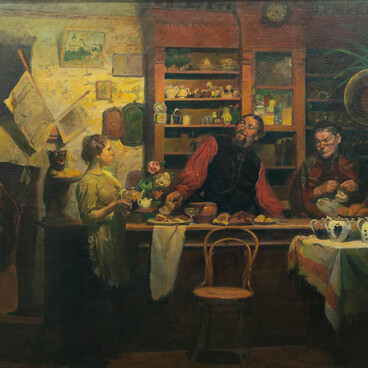Georgiy Fomiryakov was born on May 9, 1957, in Cheboksary. He graduated from the Art and Graphics department of the Chuvash State Pedagogical University named after Ivan Yakovlev. Between 1985 and 1988, he was a student of Professor Vladimir Ilyushchenko.
The artist’s works include “Winter in the Dukhovaya Grove”, “Night of the Fiery Serpent”, “Tree of Life”, “Red Calf”, “She-Wolf”, “People”, “The Fight”, “The Life-Giving Sun”, the triptych “Sage” and others.
Georgiy Fomiryakov once said in an interview, “I am convinced that by forgetting the past, we become spiritually shallower. Our ancestors’ legacy is like chests that hide countless treasures, waiting to enrich us both financially and spiritually. What I do is ‘pull out’ these treasures from the chests and pass them on to others, using the language of art. Every era, every time period creates its own language — the language of understanding and perception. As a person belonging to this era, I translate the language of our ancestors into the modern one.”
Georgiy Fomiryakov’s oeuvre mainly consists of works that reflect the artist’s philosophical reflections upon humanity, nature, and homeland. A Chuvash by origin, living in harmony with national culture, Fomiryakov remained a modern artist and thinker first. Art critics call him an ethno-futurism artist, but the significance of his work can hardly be limited to this trend. He was a tireless creator of modern Chuvash culture, making his own path in fine arts by fusing national traditions and modern influences.
One of Georgiy Fomiryakov’s early paintings called “Light and Shadow” is a visual contemplation upon the theme of the struggle of opposites. Georgiy Fomiryakov reflected on this subject, “Black and white are opposites, yet they cannot exist without one another. The fight between them is meaningless: by destroying the other, one destroys oneself.”
The artist saw his 1992 painting “The Fight” as a vivid example of the possibilities of ethno-futurism as a style. The scene of a fight between a bull and wolves, rendered on canvas in an expressive manner, required a calm background that could balance the composition. The artist chose to depict a grandma’s carpet, which served as an arena for this eternal struggle between good and evil. The even horizontal stripes of the background “stabilize” the broken forms of the animals, focused on the fight, and please the eye of the viewer after the sophisticated and peculiar ornamentation of the fighters.
The artist’s works include “Winter in the Dukhovaya Grove”, “Night of the Fiery Serpent”, “Tree of Life”, “Red Calf”, “She-Wolf”, “People”, “The Fight”, “The Life-Giving Sun”, the triptych “Sage” and others.
Georgiy Fomiryakov once said in an interview, “I am convinced that by forgetting the past, we become spiritually shallower. Our ancestors’ legacy is like chests that hide countless treasures, waiting to enrich us both financially and spiritually. What I do is ‘pull out’ these treasures from the chests and pass them on to others, using the language of art. Every era, every time period creates its own language — the language of understanding and perception. As a person belonging to this era, I translate the language of our ancestors into the modern one.”
Georgiy Fomiryakov’s oeuvre mainly consists of works that reflect the artist’s philosophical reflections upon humanity, nature, and homeland. A Chuvash by origin, living in harmony with national culture, Fomiryakov remained a modern artist and thinker first. Art critics call him an ethno-futurism artist, but the significance of his work can hardly be limited to this trend. He was a tireless creator of modern Chuvash culture, making his own path in fine arts by fusing national traditions and modern influences.
One of Georgiy Fomiryakov’s early paintings called “Light and Shadow” is a visual contemplation upon the theme of the struggle of opposites. Georgiy Fomiryakov reflected on this subject, “Black and white are opposites, yet they cannot exist without one another. The fight between them is meaningless: by destroying the other, one destroys oneself.”
The artist saw his 1992 painting “The Fight” as a vivid example of the possibilities of ethno-futurism as a style. The scene of a fight between a bull and wolves, rendered on canvas in an expressive manner, required a calm background that could balance the composition. The artist chose to depict a grandma’s carpet, which served as an arena for this eternal struggle between good and evil. The even horizontal stripes of the background “stabilize” the broken forms of the animals, focused on the fight, and please the eye of the viewer after the sophisticated and peculiar ornamentation of the fighters.



